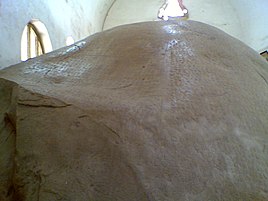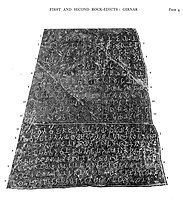
Junagadh is the city and headquarters of Junagadh district in the Indian state of Gujarat. Located at the foot of the Girnar hills, 355 kilometres (221 mi) southwest of Ahmedabad and Gandhinagar, it is the seventh largest city in the state.
The Vaghela dynasty ruled the Gujarat region in India in the 13th century CE, with their capital at Dholka. They were the last Hindu dynasty to rule Gujarat before the Muslim conquest of the region.

Skandagupta was a Gupta Emperor of India. His Bhitari pillar inscription suggests that he restored the Gupta power by defeating his enemies, who may have been rebels or foreign invaders. He repulsed an invasion by the Indo-Hephthalites, probably the Kidarites. He seems to have maintained control of his inherited territory, and is generally considered the last of the great Gupta Emperors. The Gupta genealogy after him is unclear, but he was most probably succeeded by Purugupta, who appears to have been his younger half-brother.
The Western Satraps, or Western Kshatrapas were Indo-Scythian (Saka) rulers of the western and central parts of India, between 35 and 415 CE. The Western Satraps were contemporaneous with the Kushans who ruled the northern part of the Indian subcontinent, and were possibly vassals of the Kushans. They were also contemporaneous with the Satavahana (Andhra) who ruled in Central India. They are called "Western Satraps" in modern historiography in order to differentiate them from the "Northern Satraps", who ruled in Punjab and Mathura until the 2nd century CE.

Rudradāman I was a Śaka ruler from the Western Kshatrapas dynasty. He was the grandson of the king Caṣṭana. Rudradāman I was instrumental in the decline of the Sātavāhana Empire. Rudradāman I took up the title of Maha-kshtrapa, after he became the king and then strengthened his kingdom.

Taranga is a Jain pilgrimage center near Kheralu in Mehsana district, Gujarat, India, with two compounds of Jain temples that are important examples of the Māru-Gurjara style of architecture. The Ajitnatha temple, was constructed in 1161 by the Chaulukya king Kumarapala, under the advice of his teacher, Acharya Hemachandra. Both the main sects of Jainism are represented, with adjoining walled compounds: the Svetambara compound consists of 14 temples in all, and there are also five Digambara-affiliated temples at Taranga hill.

Khedbrahma is a town and a taluka headquarter in Khedbrahma Taluka of Sabarkantha district, Gujarat, India. It is situated on the banks of Harnav river. The town is connected with mythological history and has been pilgrim site for centuries. The 11th century Brahma, Ambika and Pankhnath Mahadev temples are the oldest monuments of the town. The town has an old stepwell, the Brahma Vav. It was under Parmaras, Chaulukyas and Pariharas before it came under Idar State in 13th century.
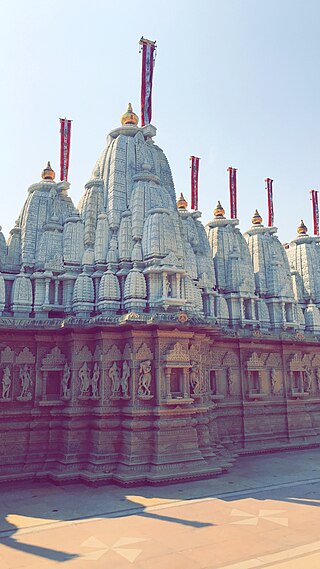
Shankheshwar is a town in the Patan district of Gujarat state of India. It is an important place of pilgrimage for the followers of Jainism.
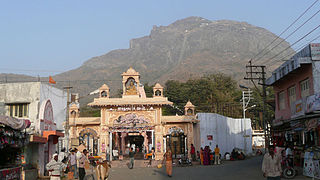
Bhavnath is a locality in Junagadh city of Gujarat, India. It sits near the Girnar mountain range, close to Girnar Taleti, the place from where pilgrims have to ascend on foot to get to temples on Girnar hills.
Jayasiṃha, who assumed the title Siddharāja, was an Indian king who ruled western parts of India. He was a member of the Chaulukya dynasty.

There is a group of temples of Jainism on Mount Girnar near Junagadh in Junagadh district, Gujarat, India. These temples are sacred to both Digambara and the Svetambara branches of Jainism.

The Junagadh rock inscription of Rudradaman, also known as the Girnar Rock inscription of Rudradaman, is a Sanskrit prose inscribed on a rock by the Western Satraps ruler Rudradaman I. It is located near Girnar hill near Junagadh, Gujarat, India. The inscription is dated to shortly after 150 CE. The Junagadh rock contains inscriptions of Ashoka, Rudradaman I and Skandagupta.
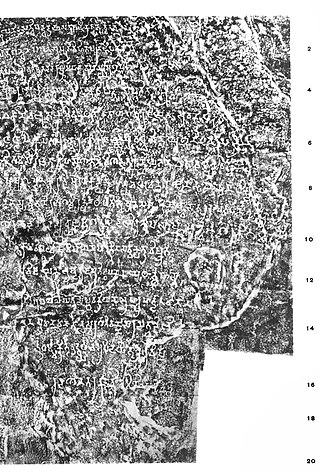
Tushaspa was a "Yavanaraja" for Emperor Ashoka, in the area of Girnar, near Junagadh, in Gujarat, India. He is only known from the Junagadh rock inscription of Rudradaman, in which the Western Satrap king Rudradaman, writing circa 150 CE, mentions his role in the construction of a local dam, in which he added a canal during the reign of Ashoka. The part of the inscription mentioning him reads:
"(L.8)……… ordered to be made by the Vaishya Pushyagupta, the provincial governor of the Maurya king Chandragupta; adorned with conduits for Ashoka the Maurya by the Yavana king Tushaspa while governing; and by the conduit ordered to be made by him, constructed in a manner worthy of a king (and) seen in that breach, the extensive dam…………..."
Ra Meliga, also known as Melaga or Maleka, was a Chudasama king of Saurashtra region of western India who reigned from 1400 CE to 1416 CE. He remove his capital from Vanthali back to Junagadh, from which place he expelled the thanadar appointed by Gujarat Sultan. Thus Gujarat Sultan Ahmad Shah I sent an army against Junagadh. He captured Vanthali and later Junagadh was besieged. Meliga left to a fort on Girnar hill which was inaccessible to the forces. So the forces left and placed two officers in Junagadh to collect tribute. Meliga died and was succeeded by his son Jayasimha II in 1416 CE.
Khengara was a Chudasama king of Saurashtra region of western India who reigned in the 12th century. His capital was at Junagadh. He was a contemporary of Jayasimha Siddharaja, the Chaulukya ruler of Anahilapataka. According to bardic tales, he was a son of Navaghana and had succeeded him.
Vastupāla was a prime minister of the Vāghelā king Vīradhavala and his successor Vīsaladeva, who ruled in what is now the Gujarat region of India, in the early 13th century. Although he served in an administrative and military capacity, he was also a patron of art, literature and public works. He, together with his brother Tejapāla, assisted in the restoration of peace in the kingdom, and served in a number of campaigns against Lāṭa, Godraha, Kutch and the Delhi Sultanate. The brothers were instrumental in the construction of the Luniga-vasahi temple on Mount Abu and the Vastupala-vihara on Girnar.
Ra Khengar Vav or Ra Khengar stepwell is a 13th-century stepwell located near Koyliphatak village between Vanthali and Junagadh in Gujarat, India.

Ambika Temple, also known as Ambaji Temple, is a temple dedicated to goddess Ambikaon Girnar hill in Junagadh, Gujarat, India. The earliest mention of the temple is recorded in the 8th century. The present temple was built in the 15th century.

Girnar ropeway is a ropeway on Mount Girnar in Junagadh district, Gujarat, India. First proposed in 1983, the construction started only in September 2018 due to government approval delays and litigation. The construction and operation is managed by Usha Breco Limited. It was inaugurated on 24 October 2020.

Neminath Jain Temple, originally known as Karnavihara, is a Jain temple dedicated to the Jain tirthankara Neminatha. It is on Girnar hill, near the city of Junagadh in Gujarat, India. The temple is the foremost temple among all of the Girnar Jain temples. The oldest part of the present temple was built c. 1129 CE, using Māru-Gurjara architecture. More shrines and idols in the temple have been installed throughout its history.




